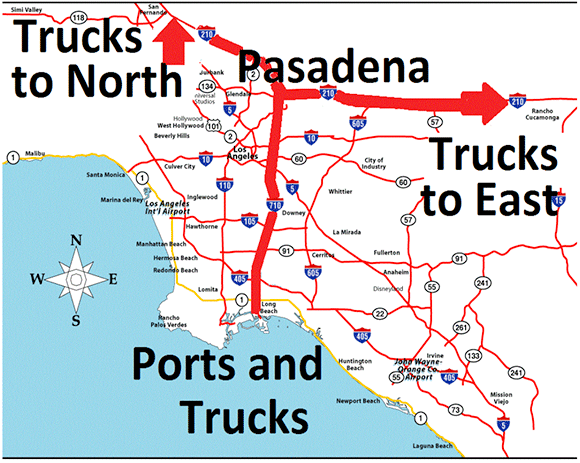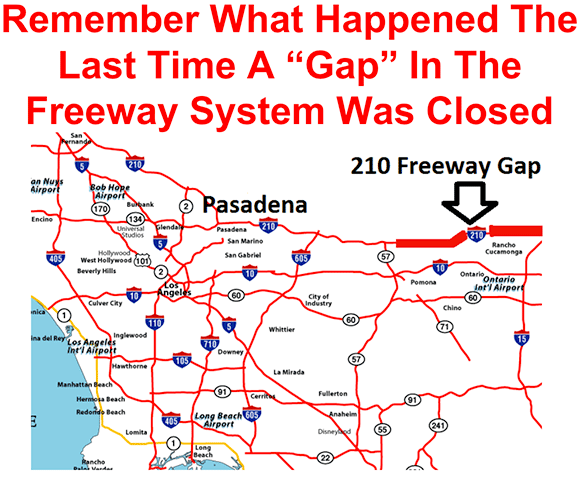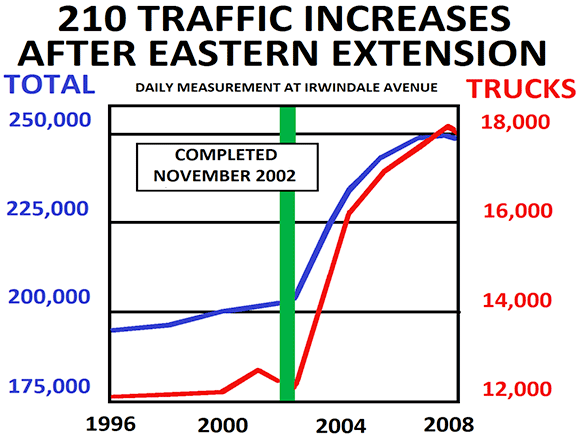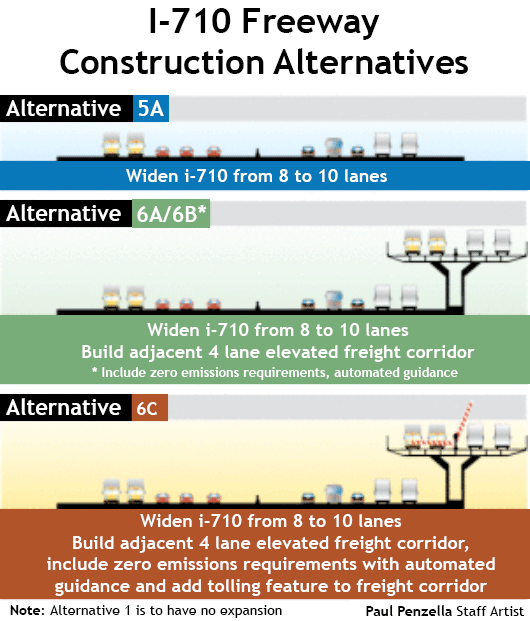Critical Issues
General
The 710 Tunnel
Threatens Pasadena
2 versions:
1 slide/pg - 8.1 MB (PDF)
4 slides/pg - 1.2 MB (PDF)
John Shaffer PowerPoint
presentation (as a PDF), 10/8/12
Houses
Caltrans Tenants Association (PDF)
In the 1960s, Caltrans purchased
almost 600 houses in advance
of building a freeway.
CA State Audit of
Caltrans Homes
In 2012, the State conducted an audit
and found that Caltrans wasted millions
in the mismanagement of
Caltrans-owned homes.
Assemblymembers Letter
to Caltrans (PDF)
Letter outlining concerns with rent increases and lack of outreach to Caltrans Tenants, 3/2013
Update on
Proposed Regulations
Caltrans Releases new Proposed Regulations on Sale of 710 Properties,3/2015
Affordable Sales Program, Proposed Regulations (PDF)
Affordable Sales
Program FAQs (PDF)
Phase 1A and Phase 1B Properties (PDF)
David Roberti Letter (PDF)
South Pasadena City
Council Letter (PDF)
West Pasadena Residents’ Association Letter to City of Pasadena (PDF)
WPRA expresses concerns about the state of the Caltrans properties in the corridor and the continued evictions. 11/15/2017
Photos of Caltrans-owned Houses (PDF)
The above are documents related to current proposed sales of Caltrans Properties
Health & Pollution
H & P Scoping Letter (PDF)
No 710 Action Committee
letter to Caltrans
Did you Know? (PDF)
Bullet points and quotes
Tunnel Info
Alternatives Analysis
Graphics, 7/11/2012 (PDF)
Metro’s proposed alternatives and alignments (routes), includes maps
Tunnel Performance (PDF)
La Cañada Flintridge's analysis of 3 traffic studies done by SCAG, USC, &
Metro showing increase
truck
traffic from closing the "gap"
I-710 SCAG, Missing Link
Truck Study (PDF)
2009 Iteris study conducted by the Southern California Association of Governments
Tunnel Ventilation (PDF)
Describes the different types of ventilation systems used in tunnels
Tunnel Boring Machine (PDF)
Shows the enormity of modern
tunnel digging machines
Tunnel Dangers (PDF)
Tunnels have inherent safety issues
What Could Happen in a Tunnel? (PDF)
Images from tunnel disasters
around the world
No 710 Letter to City of LA
Transportation Committee (PDF)
No 710 Letter Addressing City Resolution
Port Growth
Port Growth (PDF)
Goods movement at the Port of Los Angeles and Long Beach is expected to triple by 2035 which will affect the 710 North and South
It’s One Big Project (PDF)
Metro is keeping the I-710 South Expansion and SR-710 North Extension EIR's separate, but they are one freight corridor project
No 710 Letter about
Goods Movement (PDF)
Evidence that the 710 Extension
and 710 Expansion projects
have always been linked
to the movement of goods
Cost
Tunnel Cost Estimates Chart (PDF)
Graph showing the wide range of cost estimates quoted for the SR-710 North Extension
2011 Tunnel Cost Estimate (PDF)
Metro & InfraConsult summary of cost estimates to build a tunnel along the Meridian route, F-7, in response to request by MTA Board Chairman, Ara Najarian, 9/14/2011
2008 I-710 Tunnel
Financial Feasibility Assessment
MTA & Caltrans supplemental financial report outlining costs, includes toll projections
Compiled 2/7/2015
No Matter Where it's Built
It will Impact You in a Bad Way
710 Would Funnel More Trucks
and Traffic Through the Region

Freeways and Highways
- Create pollution, noise, public health, and traffic problems.
- Physically divide neighborhoods.
- Reduce property values and tax base.
- Threaten historic and cultural resources.
- Cost billions of dollars to build.
- Are 20th century "fixes" to 21st century transportation needs.

Please see the Los Angeles County's MTA
results from their 2010 study on freeway congestion

The following image is based on
possible alternatives to
increasing the road use for the I-710.
Simply, even More 710 Traffic And
Trucks May Be Coming
- Metro has released this draft EIR for "710 South" from Long Beach to SR 60.
- Up to 12 lanes pointed directly toward Pasadena.
- No Freight-By-Rail alternative has been considered.
- EIR comments due September 28, 2012.

SR-710 EXTENSION
OVERVIEW AND ISSUES
TECHNICAL
1. "Tunnel" is defined by Metro as EITHER "cut and cover" or bored through the ground. Current Metro plans do not differentiate between "cut and cover" and bored" tunnels, which Metro treats as being the same thing.
*"Cut and cover" requires removal of all homes, businesses, and other surface structures, digging a trench, building the roadway, and then covering the roadway with a concrete lid and dirt.
*"Bored tunnel" is created by digging large access pits at either end of the tunnel and inserting large boring machines. Dirt is removed through the pits. Even with bored tunnels, "cut and cover" or trench segments may be needed to access the tunnel.
*Metro uses the phrase "tunnel portal" to describe the end of EITHER "cut and cover" or "bored" tunnels.
2. Bored sections will be "twin" tunnels, one northbound, and one southbound.
3. Each tunnel will be four lanes, doubled decked with two lanes over the other two lanes.
4. Each tunnel is 57 feet in diameter, between 4.5 and 6.5 miles long (longest road tunnel in the United States). There will be no way out of the tunnel, except at the ends, or by climbing 100 to 300 feet of stairs.
5. It is anticipated that trucks would be in the upper level due to grades, so cars and trucks would have to be separated.
6. Earlier plans called for tall ventilation multi-story buildings (smoke stacks) along the route. New plans may call for all exhaust to be vented at the ends into El Sereno (F-2, F-5), Eagle Rock (F-2), Pasadena (F-5) and the other proposed route not included in the L.A. City Council resolution (F-7) for El Sereno and Pasadena. The access shaft planned for El Sereno would call for extensive surface excavation, threatening structures where that is located.
7. El Sereno is the proposed site for the access shaft. All of the dirt that is excavated by the tunnel boring machine will be moved by conveyor belt to the access shaft, loaded on trucks and transported to another site (Irwindale as a possible location) 24/7, 365 days a year, for up to 10 years until construction is complete.
FISCAL CONCERNS
1. This project has the potential for massive cost increases and construction/litigation delays.
2. Cost estimates for this project have run between $1 to $14 Billion dollars. This will likely be the single most expensive public works project in the history of Los Angeles. The high variability of the cost estimates by various governmental agencies demonstrates the substantial fiscal risk.
3. Costs of tunnel and its effects on surrounding communities threaten voter support for Measure J (the Measure R sales tax extension), and thus threaten funding for other important transit projects.
4. The final SR-710 Extension costs (including interest) have the potential to be nearly double California’s current State budget deficit of $19 Billion dollars.
5. Tunnel will likely have to be funded with private funds (a so-called PPP or Public, Private Partnership), requiring very high tolls.
6. Toll highways in Southern California have resulted in a string of financial failures and taxpayer bailouts, including the South Bay Expressway (SR 125) in San Diego County (bankruptcy, after costing nearly a half billion dollars more than projected, and requiring tolls to be extended an additional ten years), the Orange County Tollroads (which have had to lay off all toll collectors because they cannot afford to pay them), and the 91 Freeway Tollway (which failure cost the state more than $100 million in cash, and the tolls are currently the highest in the nation. Costs were estimated to be $57 million, but turned out to be $130 million).
TRAFFIC CONGESTION MITIGATION
1. The Tunnel Does Not Address Regional Commuter Needs. Metro’s own analysis to date shows that transit alternatives will better serve commuters than would the tunnel. The transit and/or TSM/TDM alternatives would reduce vehicle hours traveled by a significantly greater amount than would the Tunnels. The Tunnels would bring more traffic into Northeast Los Angeles and the San Fernando Valley. Actual experience from the extension of the 210 Freeway into Eastern Los Angeles County (circa 2002) contradicts the SR-710 Study findings and shows dramatic increases in traffic for miles west of the extension. Completion of the Tunnel would bring addition congestion onto the 210 and 134 Freeways, including into City of Los Angeles neighborhoods.
2. The Tunnel Does Not Address Regional Freight Needs. Metro admits that the purpose of its Study is to consider the movement of people, not goods. "No freight alternatives were included in the preliminary set of alternatives. Because the primary need identified for the project is to accommodate regional North – South travel demands, and the primary demand for mobility in the study area is that of people not freight". August 23rd, 2012 SR-710 Study – Summary of Results of Alternatives Analysis. Accordingly, Metro’s Study leaves a gaping question: where are all the trucks going to go? Metro should be asked to answer this question before proceeding further with the Study.
ENVIRONMENTAL ISSUES
1. Tunnel is inconsistent with City of Los Angeles’ ongoing efforts to emphasize transit over the private automobile. Metro’s emphasis should be on completing essential transit projects, including Crenshaw, Expo, and Regional Connector light rail lines, and the subway extension toward West Los Angeles.
2. Portals and ventilation stacks will cause exhaust output into the community, including El Sereno and Cal
State Los Angeles areas. Additional exhaust will come from traffic on roadways leading to and from tunnels. Slow prevailing winds will lead to greatly reduce local air quality.
3. Based on the SCAG report there will be 3 venting stacks: El Sereno, South Pasadena, and Pasadena (Huntington Hospital). Newer plans may contemplate all exhaust being vented into El Sereno and Pasadena.
4. Truck traffic will incur a 4% grade in the tunnel and will be forced to lower their gears and speeds that will produce a higher PM, NOx levels.
5. Tunnels and their encouragement of automobile traffic will increase green house gas emissions PM, NOx and other high criteria pollutants.
PALEONTOLOGICAL/CULTURAL/GEOTECHNICAL ISSUES
1. Tunnel will pass through significant active earthquake fault lines.
2. Significant risk of encountering other adverse geotechnical conditions of concern (liquefiable zones, natural gas, aquifers).
3. All tunnels will pass through areas of significant paleontological (fossils), cultural, historic, and indigenous resources, especially in tunnel’s South Portal area in El Sereno.
SAFETY CONCERNS
1. The tunnels will have limited escape shafts, requiring people to climb hundreds of feet, and would not be ADA compliant.
2. Unrestricted tunnel access represents a soft terrorist target.
3. Freeways are accident prone, and the tunnels will be no different (SR-60 Pomona Freeway, Tanker fuel truck caught on fire and destroyed the bridge). Past accidents and fires in tunnels have resulted in substantial loss of life, and create significant risk for both motorists and first responders.
